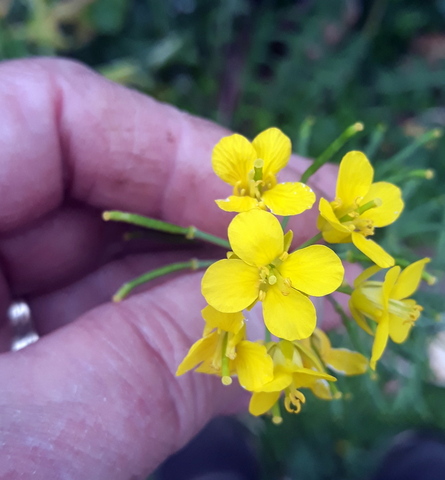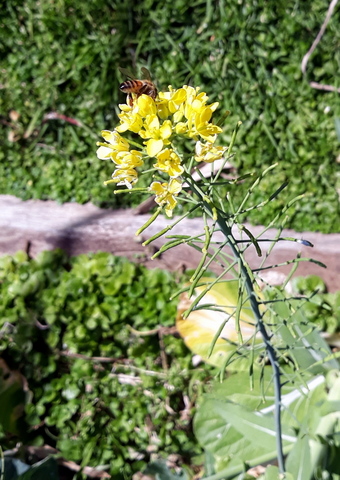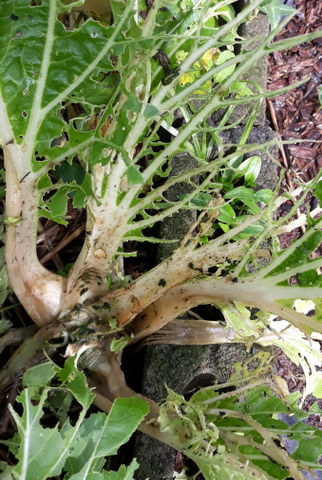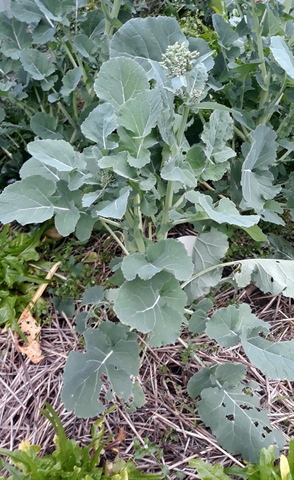Brassicas

When I use the term ‘brassicas’ I am referring to members of the Brassicaceae family, which are also known as ‘crucifers’ due to their cross-shaped flower, which includes –
• Brassica oleraceae: Broccoli, Brussel Sprouts, Cauliflower, Cabbage, collard greens, Kale, kohl rabi, kai lan
• Brassica rapa: bok choi, Choi sum, turnips, field mustard, tatsoi, wong bok
• Brassica juncea: canola, Giant red mustard, green wave mustard, mizuna
• Raphanus Sativa: Radish
• Eruca Sativa: rocket
Mostly we grow bok choi, broccoli, cabbage, cauliflower, and kale.
Our system
We grow our annual vegetables in beds 1.2m x 2m and 1.2m x 3m in rotation throughout the year, planting twice a month. We use a chook tractor to clean, till and fertilise each bed in rotation. The beds are planted out with a variety of vegetables and in the right seasons of the year, a variety of brassicas. Due to the staggered ripening time of the different brassica species, each bed provides a staged harvest of vegetables over a period of weeks to months. For more detail on our whole system, check out this link
The components
Bok Choy – this one grows almost all year round, and we sow it from January to December, leaving out July and August. It grows quickly and is first to produce, being harvested by cutting the stalks from around the outside of the plant rather than harvesting the whole plant. Eventually the bok choy bolts, how long it takes depending on the time of year, and we leave the flowering plant to provide for the bees and other beneficial insects like hoverfly. It also seeds prolifically so we do get, and use, the ‘unauthorised’ seedlings that come up.


Cabbage – usually the variety we use is the small, but fast growing ‘sugarloaf’. We sow this one year round as well, but are finding that yields during the hot weather are becoming more problematic. Because they grow quite quickly they would be the second brassica to give us a usable harvest. While I have read that cutting a cross in the top of the cut stem allows the cabbage to regrow and produce further yields I have not tried it. We did give a red cabbage (ruby ball) a go one year with some reasonable results in the colder weather.

Kale – we have tried a few varieties, but are currently using ‘dwarf green curled’. We sow kale from March to June and once they get to harvestable size, we can continue to pick leaf by leaf until the chook tractor comes around to clear the bed up.

Broccoli – We sow a sprouting variety, usually Italian Sprouting or green sprouting broccoli and sow them from January to September although the sowing later in the year is likely to be wound back further. Years ago we would sow year round but with the heating up of western Sydney getting a crop during warmer parts of the year became more and more difficult. Broccoli would take the second longest of our brassicas to crop. By growing sprouting varieties we can extend the harvest by leaving the plant in place after the main head is harvested and continuing to harvest the side shoots as they come on. This allows us to get a harvest continuing up until the chook tractor arrives at that particular patch.

Cauliflower – we sow a smaller variety like snowball or the misleadingly named ‘all year round’, sowing from January to July, but again, due to the heat up of western Sydney, the window for cropping cauliflower is shrinking. It takes the longest to crop and may be cropping just ahead of the chook tractor. I have also read of increasing the yield by cutting a cross on the stalk after the main head is harvested but have not tried it.


Other Brassicas
Brussel Sprouts – back in the day I tried growing them, I find them disgusting personally, but Linda likes them. Even then, Western Sydney did not stay cold enough for long enough to get a meaningful crop, so after a couple of tries I gave up.
Asian Greens – over the years we have successfully grown mibuna, mizuna, tatsoi, wong bok and kai lan, but we were not able to sufficiently integrate them into our diet. In the end they were just taking up space to provide the odd leaf for a salad or stir fry (and the salads around here are pretty Anglo, let me tell you!) so we gave up growing them. Also, some had a tendency to get quite strongly flavoured and bitter, which did not fit our flavour profile either! We have been doing a bit more with leafy crops recently so there is a possibility that one or more may be re-integrated into our system in the future.
Radishes – I have grown these in the past but I am not a huge fan of them so we have not grown them a lot. I did have some fun experimenting with radishes, growing them outside the main production schedule, the results of which can be found here.
Rocket - This is another brassica which can bolt to seed quickly and reseeds voluminously. We have home saved seed but only sow it every so often when we feel like an addition to our salads
So what could possibly go wrong?
The system works pretty well for us and is quite productive, but there is the odd thing that can go wrong to a greater or lesser extent –
- Pests – I am talking about the ubiquitous cabbage white butterfly and the less often seen but more destructive cabbage moth. The white butterfly attacks the leaves but the moth produces more caterpillars and they go straight for the centre of the plant, the bit we most often want to eat. They are mostly a problem during the warmer parts of the year but in the colder parts when the brassicas are really producing they are less of an issue. We have found covering the beds with mesh to keep them out works, but if we get a bad infestation of either (or both) we have found that Dipel (bacillus Thuringiensis) which is an organic spray, which clears things up pretty quickly.

- Rain bombs – or huge rainfalls over a short to medium time frame. This is new, showing up the first time for us this year. We got several in the space of a couple of months and it really beat the living daylights out of the veggie growing, drowning some brassicas before they had a chance to get going. To keep the veggie supply up I was forced to buy some commercial seedlings and while they did the job well, we were not able to get sprouting varieties so we didn’t get the long term brassica production we were used to. I don’t have a definitive answer to the rain bomb problem but if it keeps happening I will have to come up with something!
- Dud Seeds – Due to various issues I have been using commercial sprouting broccoli seeds, and the last load of seeds seems to have thrown back to a more primitive ancestor, one that produces great leaves but a tiny flower head which is hardly worth bothering about. We have been eating the seeds but when you have been looking forward to nice broccoli heads to stir fry for dinner it is a bit of a disappointment. Also, due the time lag between sowing and getting a harvest it took some time for me to catch on that there was a problem and change seeds.

Conclusion
Despite the aforementioned issues, by planting different brassicas in each bed as well as succession planting in successive beds twice a month, we have been able to provide a regular supply of members of the Brassicaceae family so that we eat well and stay healthy.



